First mobile wave
"Omnia mea mecum porto" (I carry everything with me)
As he tried to calculate, the functions of how many devices a modern smartphone can perform. I counted about thirty and, for sure, missed something. And all this in your pocket, mobile version. Mobility is a very attractive property. The need to constantly carry with you something electronic, small and useful originated long ago, 60 years ago. Then this first wave of mobile devices rose. And of course, the first were portable radios. Laptops, laptops, palmtops, tablets, smartphones it was all later.
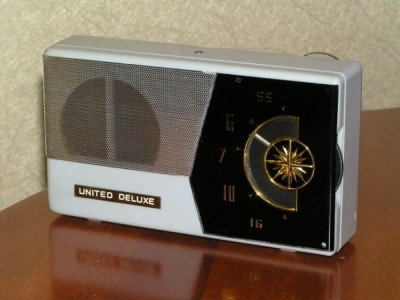
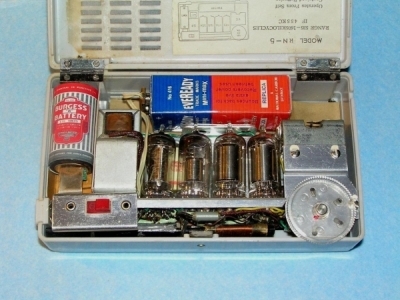
In the photo to attract attention, the wonderful Japanese pocket radio of the mid-50s United Deluxe RN-5. Its dimensions are 167x97x45 mm. Yes, warm, yes lamp. Power - two batteries, anodic at 67.5 volts and filament - 1.5 volts. For our northern country - what we need. Unfortunately, the domestic industry has not mastered anything like this. But mastered a lot more. I want to tell about it. The article used photos from the wonderful site dedicated to domestic radio engineering www.rw6ase.narod.ru .
We will recall the most popular and exotic first domestic portable (well, or in the modern reading - mobile) devices.
')
In the mid-1950s, the first portable portable radio receivers appeared in the USSR. Perhaps the first of them - the radio "Road". This ebony suitcase weighing 4.5 kg. Year 1954. To be honest, I did not have to see him live. New, unusual product. It seems the popularity is not found and is mentioned only because it was the first.


The next “Radio” tube radio receiver, which was produced at the famous VEF factory in Riga, was very popular until the advent of transistor receivers. Year of manufacture - 1955. It weighed 2.4 kg and could work on batteries for up to 30 hours. He also had a “docking station” in which the rectifier for mains supply was located. He worked in the range of DV and ST.

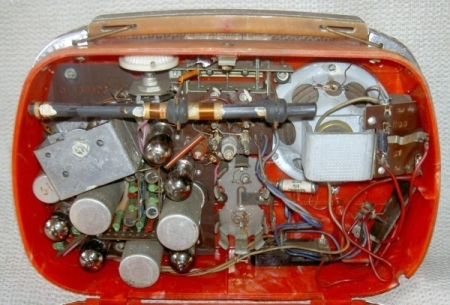
Since 1956, production of domestic transistor radios began. Until 1959, these were mainly experimental batches of several thousand pieces, and the weather, so to speak, was not done. The first mass receiver is perhaps the Atmosphere, of the Voronezh radio plant. It went on sale in 1959. The parameters are approximately the same as in the previously described lamp counterparts, but the weight has decreased by another 2 times - 1.3 kg. With a light hand of consumers who do not particularly understand the names of products, such radios have received a simple name - “Transistor”. Quite normal phrases of those years - “listen to the transistor”, “capture the transistor”, “batteries in a transistor”, etc. It must be said that the shortage of "transistors" in those years gave rise to the process of their mass self-production. The “Moscow” receiver circuit on 5 transistors designed by V. Plotnikov was very popular. The scheme was published in the magazine "Radio" in 1958. The most popular case for such products were plastic soap dishes. So such a receiver was often called simply “Soap Dish”. Many years later, small-size film cameras were called "soapbox".
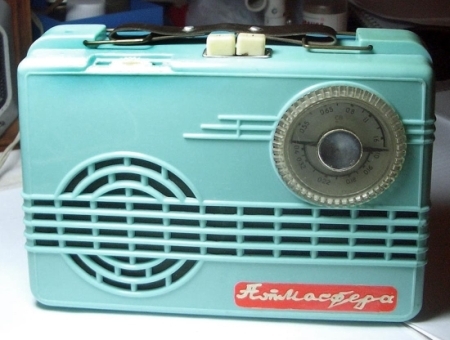

Rare radio in 1960 - "Leningrad". Scheme and design - an attempt to repeat the "Trans-Oceanic Royal-1000" - 1957 release, the American company "Zenith". Assembled on 10 transistors. There are already 7 bands - LW, MW, and 5 HF sub-bands. Drum switch ranges, power stabilizer, allowing you to maintain performance while reducing power from 12V to 8V.


Probably the most popular portable receiver in the USSR is the Speedola. It was produced since 1960 by the Riga Radio Factory VEF and was famous for its high reliability. In the following years, many modifications of it were released (VEF-Spidola, VEF-Spidola10, VEF-Transistor, VEF12). Possession of this miracle of technology was the dream of so many. The owner of the Speedo, walking down the street with his pet, looked almost like a modern major driving a Mercedes SLK convertible. I must say that before the advent of portable tape recorders, a promenade with the “transistor” turned on was common. And it doesn't matter what sounds from the receiver - Russian folk songs, news bulletins or radio plays.
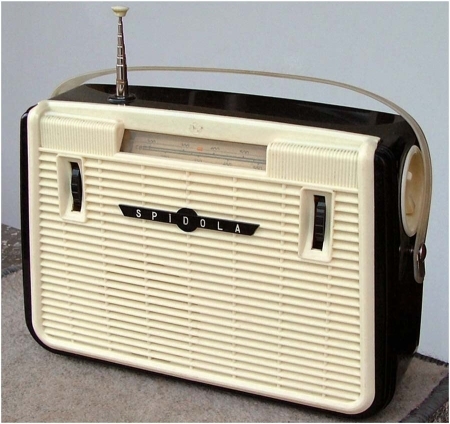

Another popular product of the VEF plant is the Selga pocket radio. We note a proud inscription - “7 transistor” on the front panel. The more - the steeper. Imagine such an inscription on a smartphone, for example "4567732512 transistor".

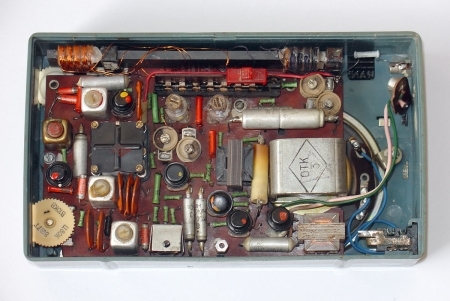
The real palmtop of 1963 is the Cosmos radio. Receiver dimensions - 27x60x70 mm. Its mass is 150 g. By the way, the receiver was exported to many countries (Cuba, Greece, Libya, Bulgaria, Yugoslavia, Afghanistan, Belgium, England).
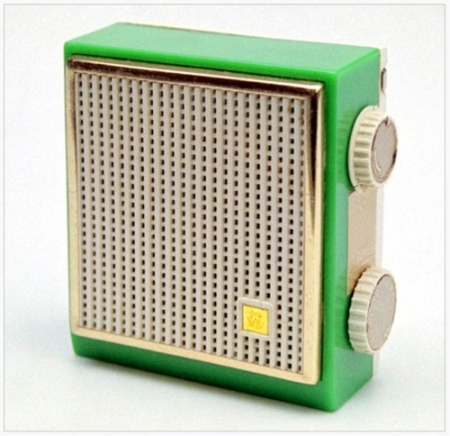

The first attempt to combine different devices into one unit is the Signal radio receiver. 1964 edition. In addition to the receiver itself, there is a watch in the case. They allowed him to turn on at a given time. Wake up and sing.
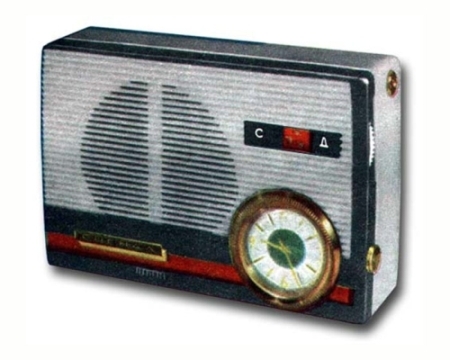
Miniature transistor radio "Micro" since 1965 produced Zelenograd factory "Angstrom". We can say that it is made well, almost on integrated circuits. In the radio receiver, six layers of different materials are formed on the board from the sitalla through special stencils, which form resistances, conductors, contact pads, capacitor plates and insulation. Transistors in the receiver are discrete.
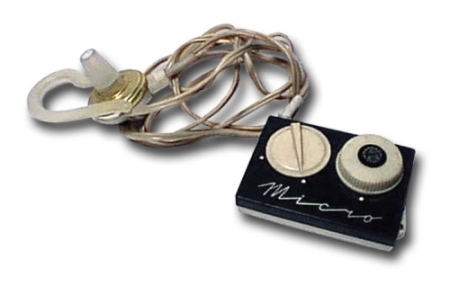
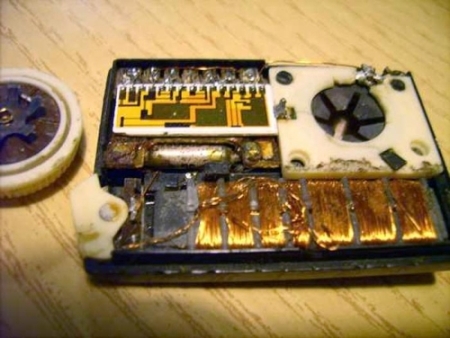
The next original exhibit is a real laptop, in the original sense of the word. Notebook, and in it a radio. Radio "Surprise" 1967 release. This was achieved through the use of a specially created miniature loudspeaker 4 mm high. The dimensions of the receiver, along with a notebook 135x88x17 mm. As you can see, the marketing moaning about the thickness of smartphones is a well forgotten old.
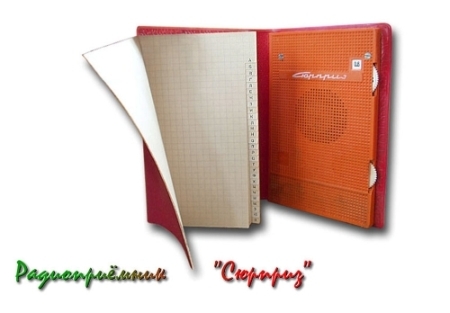
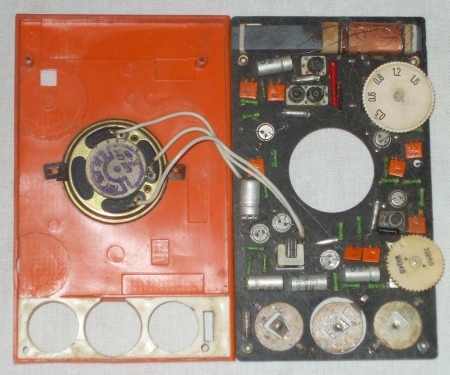
Today there are whole product lines (laptops, tablets, smartphones) for special purposes. For military, for industrial conditions, etc. The MP-64 (Sinichka) 1967 radio receiver of release is intended mainly for political instructors of all ranks in military schools and in the army to track news and events taking place in the world and for subsequent transmission of information on political studies. Ranges - DV, SV, KV. Appearance immediately gives you the opportunity to understand that there is something especially special and ideologically restrained in front of you.


Let's take a look in 1974 and get to know another mobile device - the first high-class portable radio receiver, the Leningrad-002. Its wooden case is veneered with precious wood. Ranges DV, NE, HF and VHF. The only drawback is the weight with batteries of about 10 kg. True, walks with the "transistor" by this time are already a thing of the past. A pity, it was a good sports equipment for music lovers.

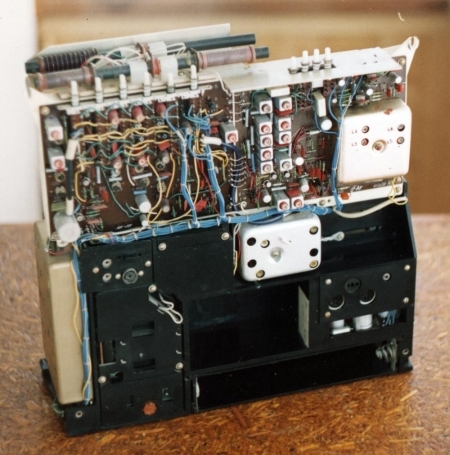
But what if you absolutely need freedom of choice, what to listen to and when to listen? Then, of course, “Mriya” is the device for you. The first and only portable radio (radio + record player). Released in 1967. In the left hand - a stack of records, in the right "Mriya". He stopped, found a flat surface, installed "Mriya", put a record of the company "Melody" and enjoy the freedom of choice.
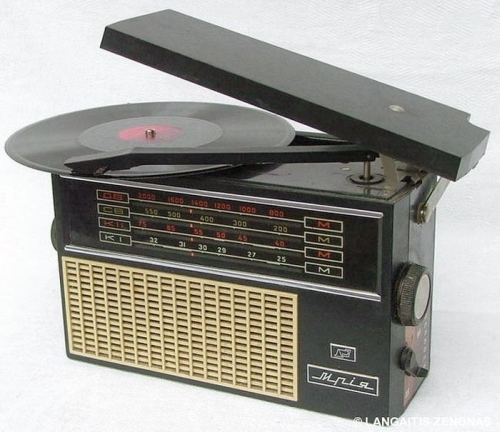
A portable tape recorder is complete emancipation. You are no longer just a listener at the Mayak radio station and a client of Melodiya, but a truly free person. The first domestic mass portable tape recorder "Spring", edition 1963. The capacity of cassettes with magnetic tape type 2 or 6 is about 100 meters. The speed of the tape is 9.53 cm / sec. The recording time on each track is 17 minutes.
Weight 5.5 kg. The second concert of Rachmaninov for piano and orchestra (duration 35 minutes), unfortunately, will require 2 tapes and double their permutation. But a few songs of Elvis Presley can be heard without being distracted by manipulations with the tape.


The “Romantic” tape recorder of 1965 was weighed with batteries of 5 kg. Continuous recording time when using 2x30 minutes coil of 180 meters of magnetic tape.


The first domestic cassette tape recorder "Desna" appeared in 1969. This was an almost exact copy of the Philips EL-3300 tape recorder, produced in 1967. A weight of 1.8 kg is radial! Included, unfortunately, was not attached with a pencil with edges. The user himself had to attend to the purchase of a pencil from the Czech company "Koh-i-Noor" for manual rewinding of a jammed tape.
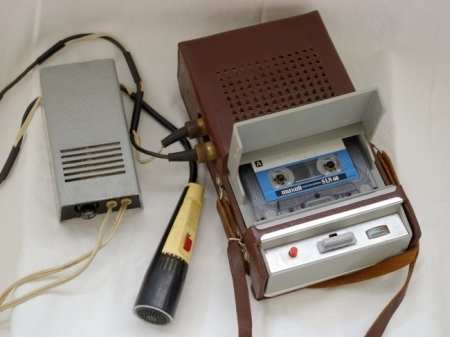

I deliberately limited the "first mobile wave" to the period of the 50s-60s. Then it was really new and fresh. The perception of time is a subjective thing. For someone, the description is “gray-haired old”, but for someone it was just yesterday.
As he tried to calculate, the functions of how many devices a modern smartphone can perform. I counted about thirty and, for sure, missed something. And all this in your pocket, mobile version. Mobility is a very attractive property. The need to constantly carry with you something electronic, small and useful originated long ago, 60 years ago. Then this first wave of mobile devices rose. And of course, the first were portable radios. Laptops, laptops, palmtops, tablets, smartphones it was all later.


In the photo to attract attention, the wonderful Japanese pocket radio of the mid-50s United Deluxe RN-5. Its dimensions are 167x97x45 mm. Yes, warm, yes lamp. Power - two batteries, anodic at 67.5 volts and filament - 1.5 volts. For our northern country - what we need. Unfortunately, the domestic industry has not mastered anything like this. But mastered a lot more. I want to tell about it. The article used photos from the wonderful site dedicated to domestic radio engineering www.rw6ase.narod.ru .
We will recall the most popular and exotic first domestic portable (well, or in the modern reading - mobile) devices.
')
In the mid-1950s, the first portable portable radio receivers appeared in the USSR. Perhaps the first of them - the radio "Road". This ebony suitcase weighing 4.5 kg. Year 1954. To be honest, I did not have to see him live. New, unusual product. It seems the popularity is not found and is mentioned only because it was the first.


The next “Radio” tube radio receiver, which was produced at the famous VEF factory in Riga, was very popular until the advent of transistor receivers. Year of manufacture - 1955. It weighed 2.4 kg and could work on batteries for up to 30 hours. He also had a “docking station” in which the rectifier for mains supply was located. He worked in the range of DV and ST.


Since 1956, production of domestic transistor radios began. Until 1959, these were mainly experimental batches of several thousand pieces, and the weather, so to speak, was not done. The first mass receiver is perhaps the Atmosphere, of the Voronezh radio plant. It went on sale in 1959. The parameters are approximately the same as in the previously described lamp counterparts, but the weight has decreased by another 2 times - 1.3 kg. With a light hand of consumers who do not particularly understand the names of products, such radios have received a simple name - “Transistor”. Quite normal phrases of those years - “listen to the transistor”, “capture the transistor”, “batteries in a transistor”, etc. It must be said that the shortage of "transistors" in those years gave rise to the process of their mass self-production. The “Moscow” receiver circuit on 5 transistors designed by V. Plotnikov was very popular. The scheme was published in the magazine "Radio" in 1958. The most popular case for such products were plastic soap dishes. So such a receiver was often called simply “Soap Dish”. Many years later, small-size film cameras were called "soapbox".


Rare radio in 1960 - "Leningrad". Scheme and design - an attempt to repeat the "Trans-Oceanic Royal-1000" - 1957 release, the American company "Zenith". Assembled on 10 transistors. There are already 7 bands - LW, MW, and 5 HF sub-bands. Drum switch ranges, power stabilizer, allowing you to maintain performance while reducing power from 12V to 8V.


Probably the most popular portable receiver in the USSR is the Speedola. It was produced since 1960 by the Riga Radio Factory VEF and was famous for its high reliability. In the following years, many modifications of it were released (VEF-Spidola, VEF-Spidola10, VEF-Transistor, VEF12). Possession of this miracle of technology was the dream of so many. The owner of the Speedo, walking down the street with his pet, looked almost like a modern major driving a Mercedes SLK convertible. I must say that before the advent of portable tape recorders, a promenade with the “transistor” turned on was common. And it doesn't matter what sounds from the receiver - Russian folk songs, news bulletins or radio plays.


Another popular product of the VEF plant is the Selga pocket radio. We note a proud inscription - “7 transistor” on the front panel. The more - the steeper. Imagine such an inscription on a smartphone, for example "4567732512 transistor".


The real palmtop of 1963 is the Cosmos radio. Receiver dimensions - 27x60x70 mm. Its mass is 150 g. By the way, the receiver was exported to many countries (Cuba, Greece, Libya, Bulgaria, Yugoslavia, Afghanistan, Belgium, England).


The first attempt to combine different devices into one unit is the Signal radio receiver. 1964 edition. In addition to the receiver itself, there is a watch in the case. They allowed him to turn on at a given time. Wake up and sing.

Miniature transistor radio "Micro" since 1965 produced Zelenograd factory "Angstrom". We can say that it is made well, almost on integrated circuits. In the radio receiver, six layers of different materials are formed on the board from the sitalla through special stencils, which form resistances, conductors, contact pads, capacitor plates and insulation. Transistors in the receiver are discrete.


The next original exhibit is a real laptop, in the original sense of the word. Notebook, and in it a radio. Radio "Surprise" 1967 release. This was achieved through the use of a specially created miniature loudspeaker 4 mm high. The dimensions of the receiver, along with a notebook 135x88x17 mm. As you can see, the marketing moaning about the thickness of smartphones is a well forgotten old.


Today there are whole product lines (laptops, tablets, smartphones) for special purposes. For military, for industrial conditions, etc. The MP-64 (Sinichka) 1967 radio receiver of release is intended mainly for political instructors of all ranks in military schools and in the army to track news and events taking place in the world and for subsequent transmission of information on political studies. Ranges - DV, SV, KV. Appearance immediately gives you the opportunity to understand that there is something especially special and ideologically restrained in front of you.


Let's take a look in 1974 and get to know another mobile device - the first high-class portable radio receiver, the Leningrad-002. Its wooden case is veneered with precious wood. Ranges DV, NE, HF and VHF. The only drawback is the weight with batteries of about 10 kg. True, walks with the "transistor" by this time are already a thing of the past. A pity, it was a good sports equipment for music lovers.


But what if you absolutely need freedom of choice, what to listen to and when to listen? Then, of course, “Mriya” is the device for you. The first and only portable radio (radio + record player). Released in 1967. In the left hand - a stack of records, in the right "Mriya". He stopped, found a flat surface, installed "Mriya", put a record of the company "Melody" and enjoy the freedom of choice.

A portable tape recorder is complete emancipation. You are no longer just a listener at the Mayak radio station and a client of Melodiya, but a truly free person. The first domestic mass portable tape recorder "Spring", edition 1963. The capacity of cassettes with magnetic tape type 2 or 6 is about 100 meters. The speed of the tape is 9.53 cm / sec. The recording time on each track is 17 minutes.
Weight 5.5 kg. The second concert of Rachmaninov for piano and orchestra (duration 35 minutes), unfortunately, will require 2 tapes and double their permutation. But a few songs of Elvis Presley can be heard without being distracted by manipulations with the tape.


The “Romantic” tape recorder of 1965 was weighed with batteries of 5 kg. Continuous recording time when using 2x30 minutes coil of 180 meters of magnetic tape.


The first domestic cassette tape recorder "Desna" appeared in 1969. This was an almost exact copy of the Philips EL-3300 tape recorder, produced in 1967. A weight of 1.8 kg is radial! Included, unfortunately, was not attached with a pencil with edges. The user himself had to attend to the purchase of a pencil from the Czech company "Koh-i-Noor" for manual rewinding of a jammed tape.


I deliberately limited the "first mobile wave" to the period of the 50s-60s. Then it was really new and fresh. The perception of time is a subjective thing. For someone, the description is “gray-haired old”, but for someone it was just yesterday.
Source: https://habr.com/ru/post/395181/
All Articles